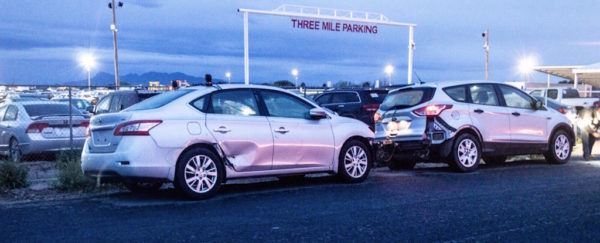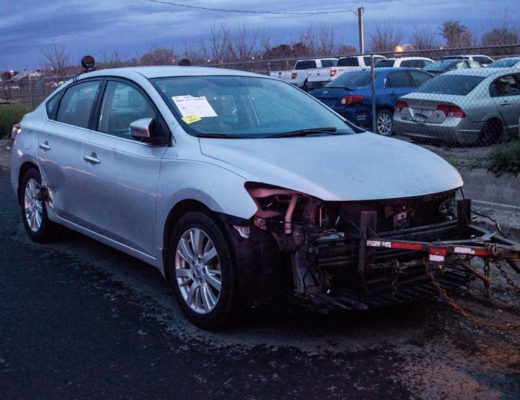TORNILLO, Tx — This small town in eastern El Paso County has less than 2,000 residents, but is far from being tranquil as a jangly parade of used vehicles bound for Mexico are hauled through its streets every day.
“The amount of traffic that goes by the front of the house is terrible because a lot of those guys are pulling two or three cars. Parts are falling off of them, it’s a hazard for us” said longtime Tornillo resident Jay Martin.
El Paso County Commissioner Vince Perez said the vehicles started moving through Tornillo in huge numbers when the U.S. port of entry with Mexico opened in 2016. Previously, used vehicles were being imported into Mexico through port of entry at Santa Teresa, N.M., but when the Tornillo port opened it was designated as the sole crossing point for this sector.

Cars line up outside the Three Mile Parking lot in Tornillo, Texas. Photo by Idalia Suarez, Borderzine.com
Perez said the traffic has improved some since Mexico imposed restrictions on used car imports to limit imports of lower quality vehicles and help protect domestic auto vendors.
“The problem was much worse when it first began back in 2016. Part of reason was that Mexico was accepting – I want to say they were accepting over a thousand cars a day – then they significantly reduced the number to one hundred a day,” he said.
Meanwhile, about a dozen car lots have opened up in Tornillo and the nearby city of Fabens where vehicles are stored until they can be crossed into Mexico. Approximately 80 to 100 used vehicles cross the port each day, according to U.S. Customs and Border Protection spokesman Roger Maier.
Tornillo residents like Jorge Aguirre worry that their property and other land around will be devalued by the vehicle lots and roadside debris.
“The property value is going to be affected because if I ever decide to sell my place my property will go down the drain,” Aguirre said. However, real estate agent Octavio Duarte said property values in Tornillo have remained stable since 2016.

A salvage car ready to be transported into Mexico through the Tornillo, Texas, crossing.
El Paso county officials put up signs to near the port of entry warning salvage vehicle transporters that they are not allowed to park close to the port.
“We did that because at the height of the problem there was a line of over three miles of cars that were parking in front of people’s driveways, parking on farmlands,” Perez said. “A lot of these cars aren’t in very good condition. They were leaking oil so there was an environmental concern. It was a very dangerous situation there were also fights that were breaking out because people were getting upset about maybe someone jumping the line.”
Perez said the no parking signs were a first step, put not a permanent solution.
“If I had my way I wouldn’t have any of these cars there going to the port of entry. It’s not what we envisioned for the port of entry, it’s not what my predecessors had envisioned for the port of entry.”
As a resident, Aguirre said he is also concerned about the potential damage the used vehicles sitting for a long time in dirt lots pose to the area’s farmlands.
“As a person that likes livestock and agriculture, I’m just afraid it’ll affect the impact of the environment. I’m pretty sure there’s a lot of oil leaks, stuff that shouldn’t be on the ground might affect the water table,” he said.
Perez expects that the Tornillo port of entry will remain as the primary crossing for used vehicles being imported into Mexico until it grows to have more commercial and commuter traffic.

